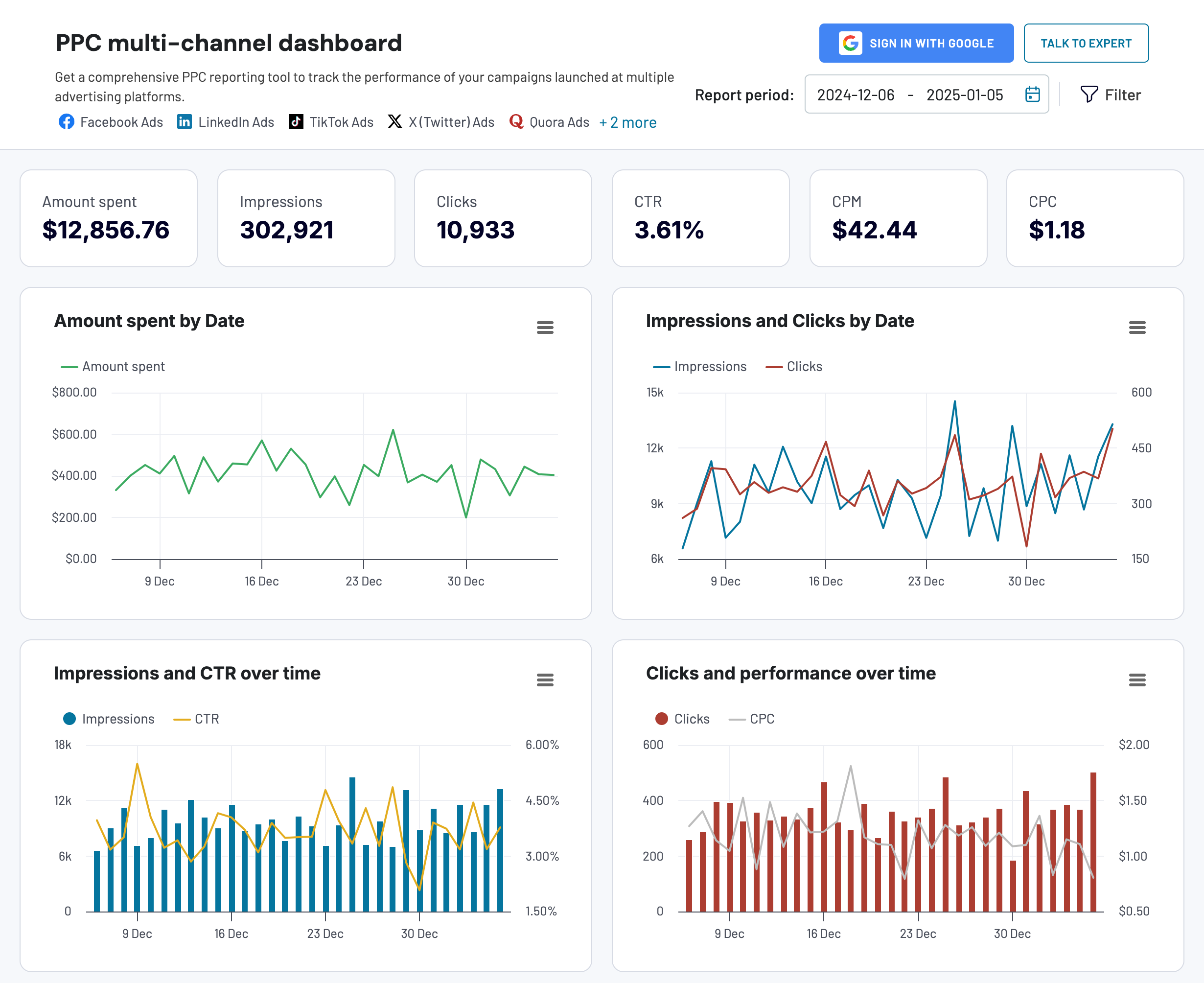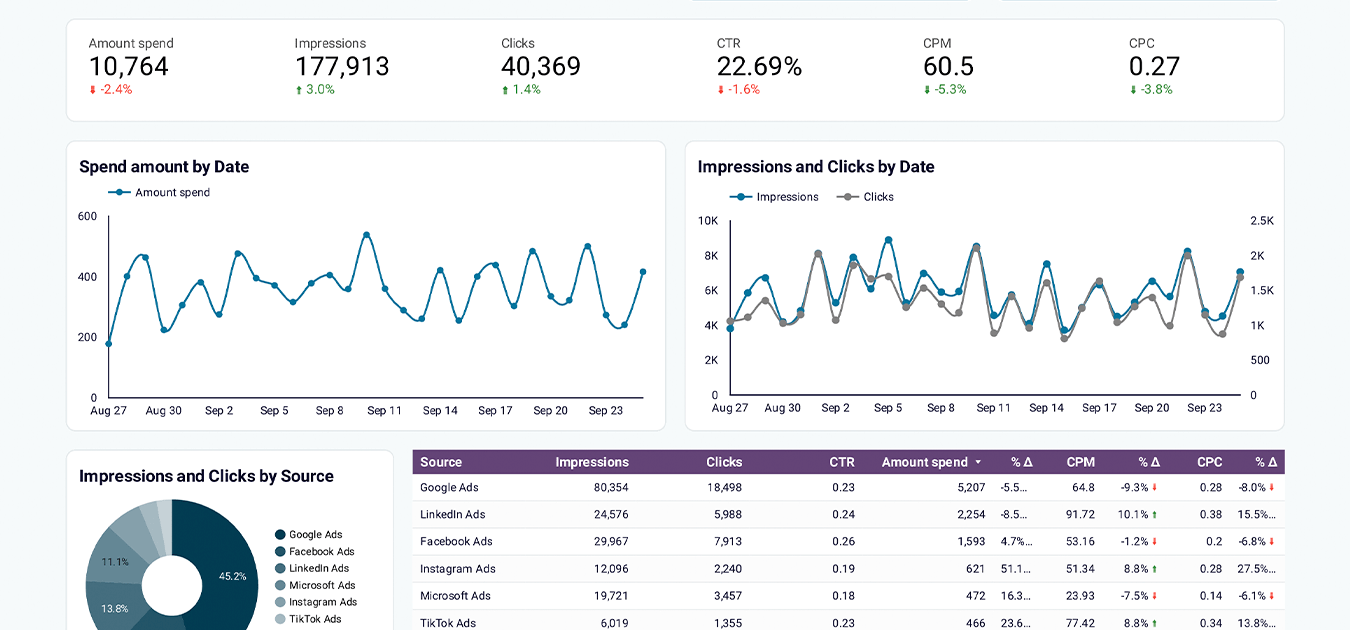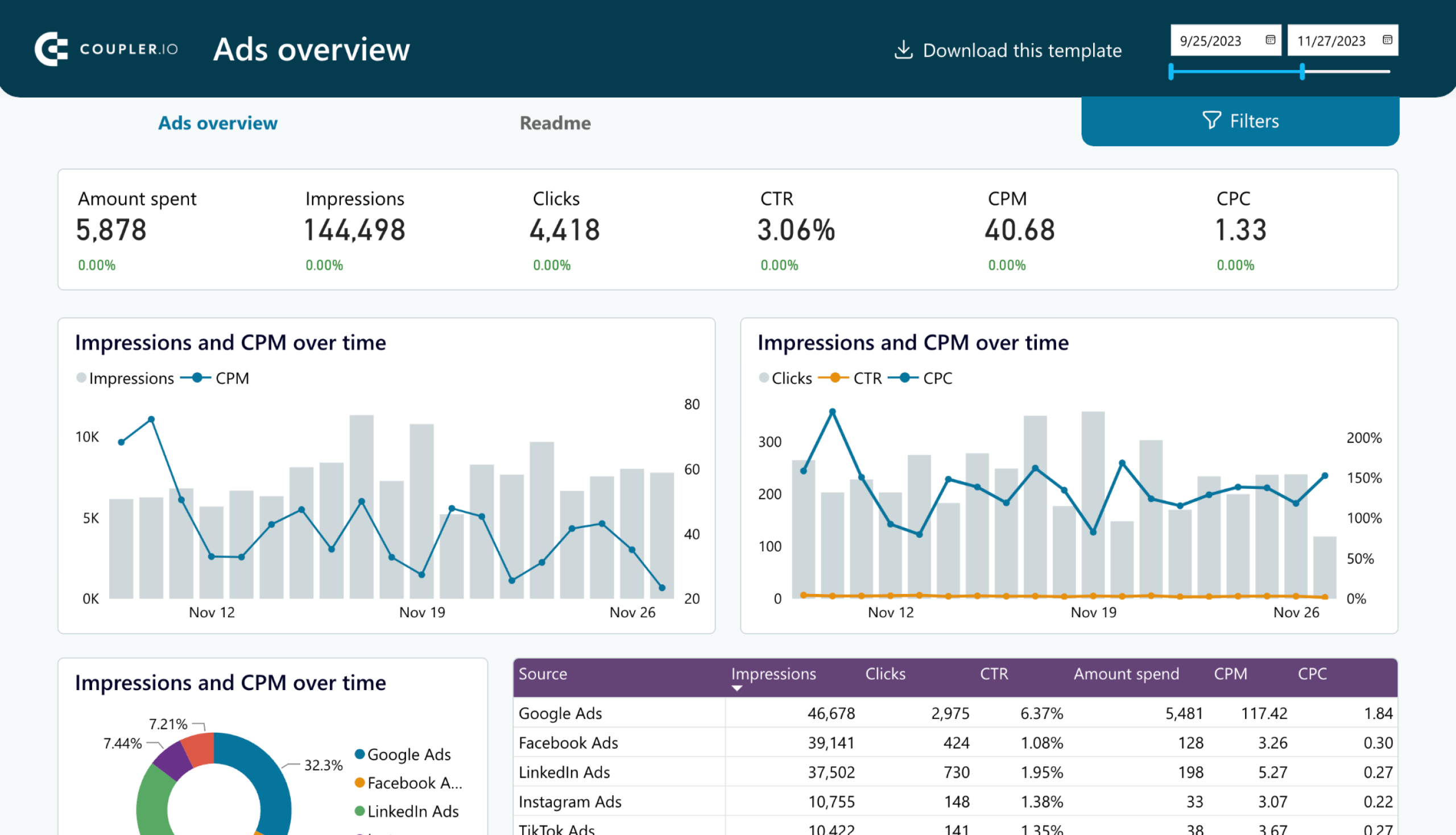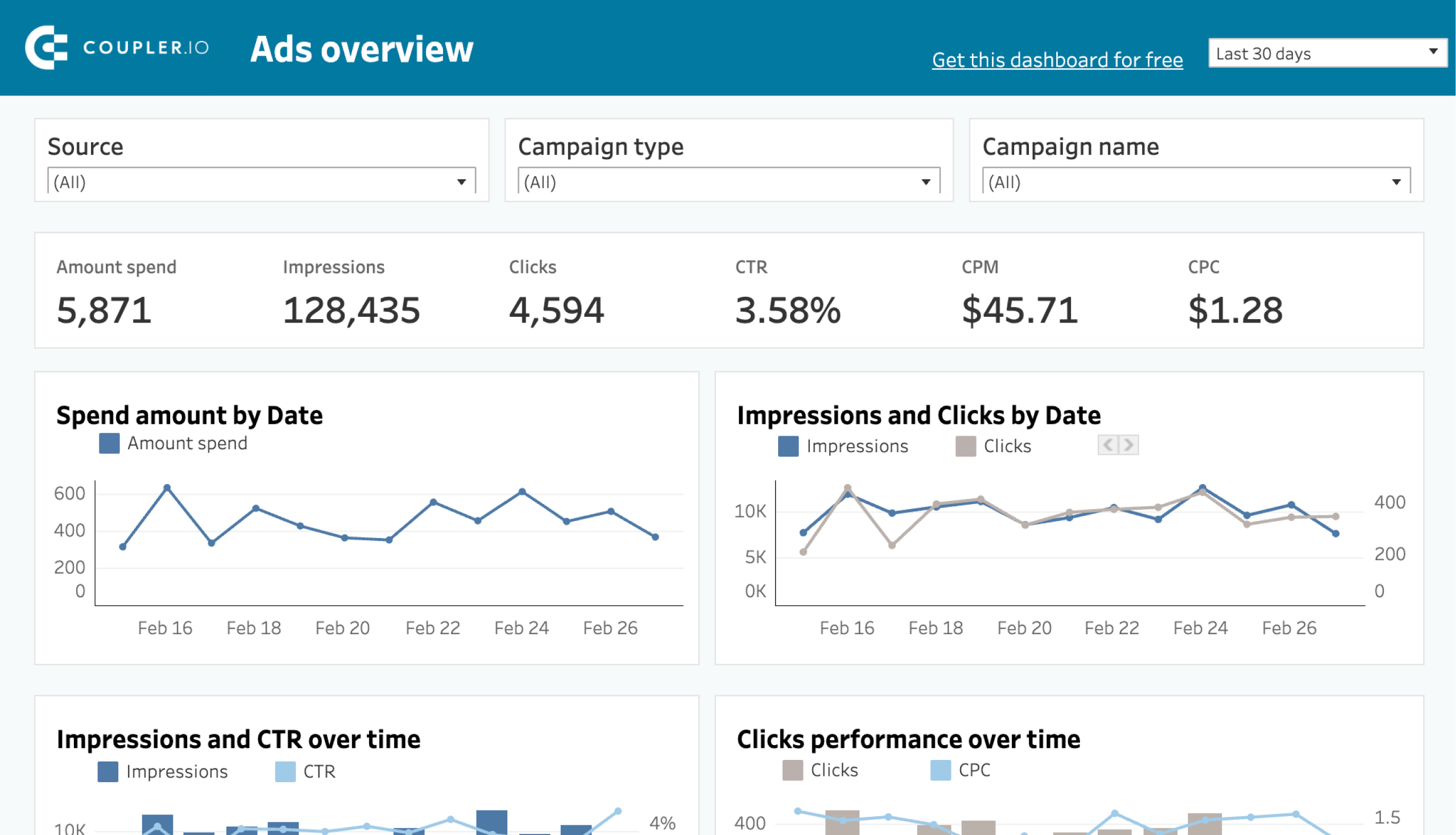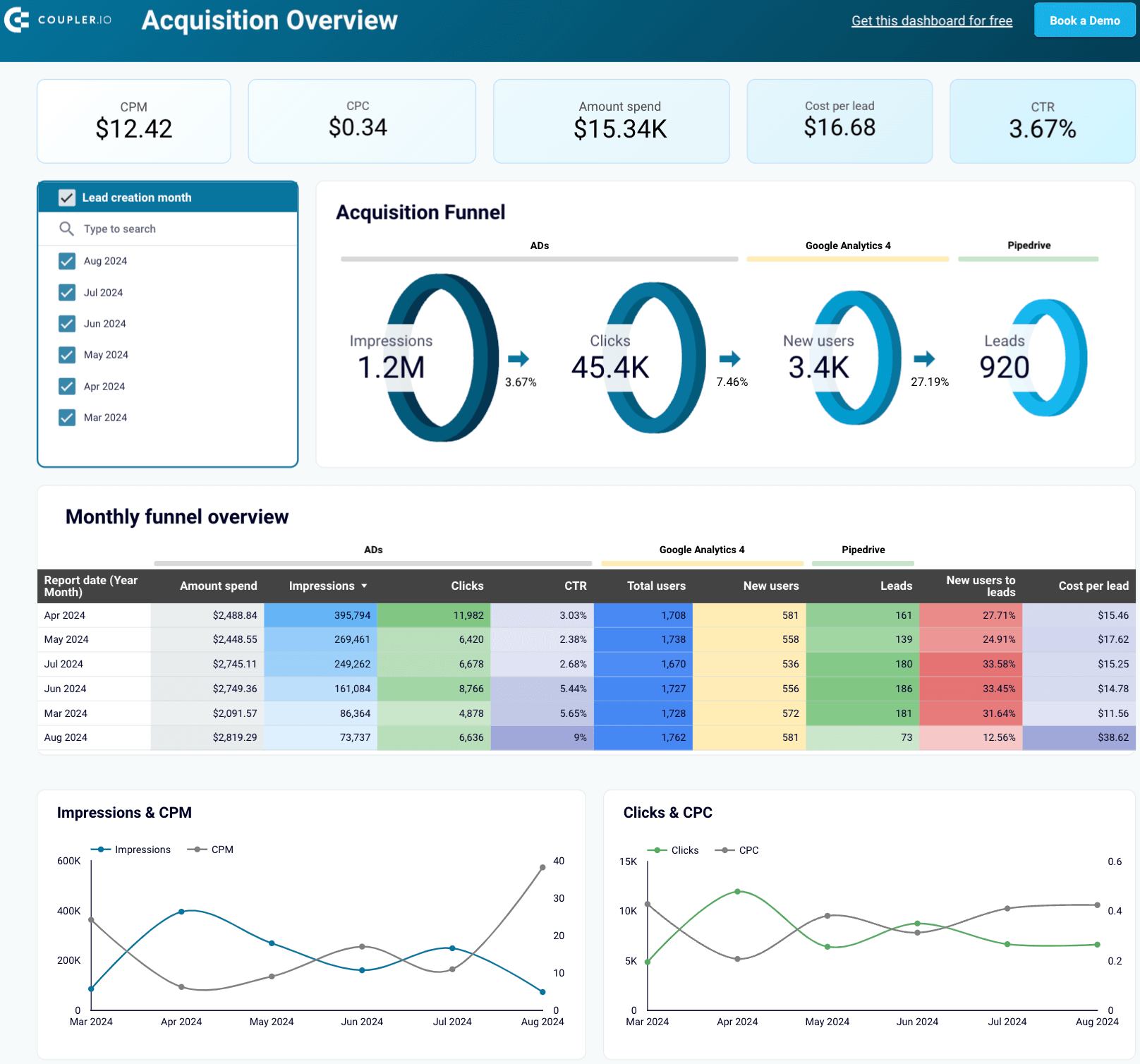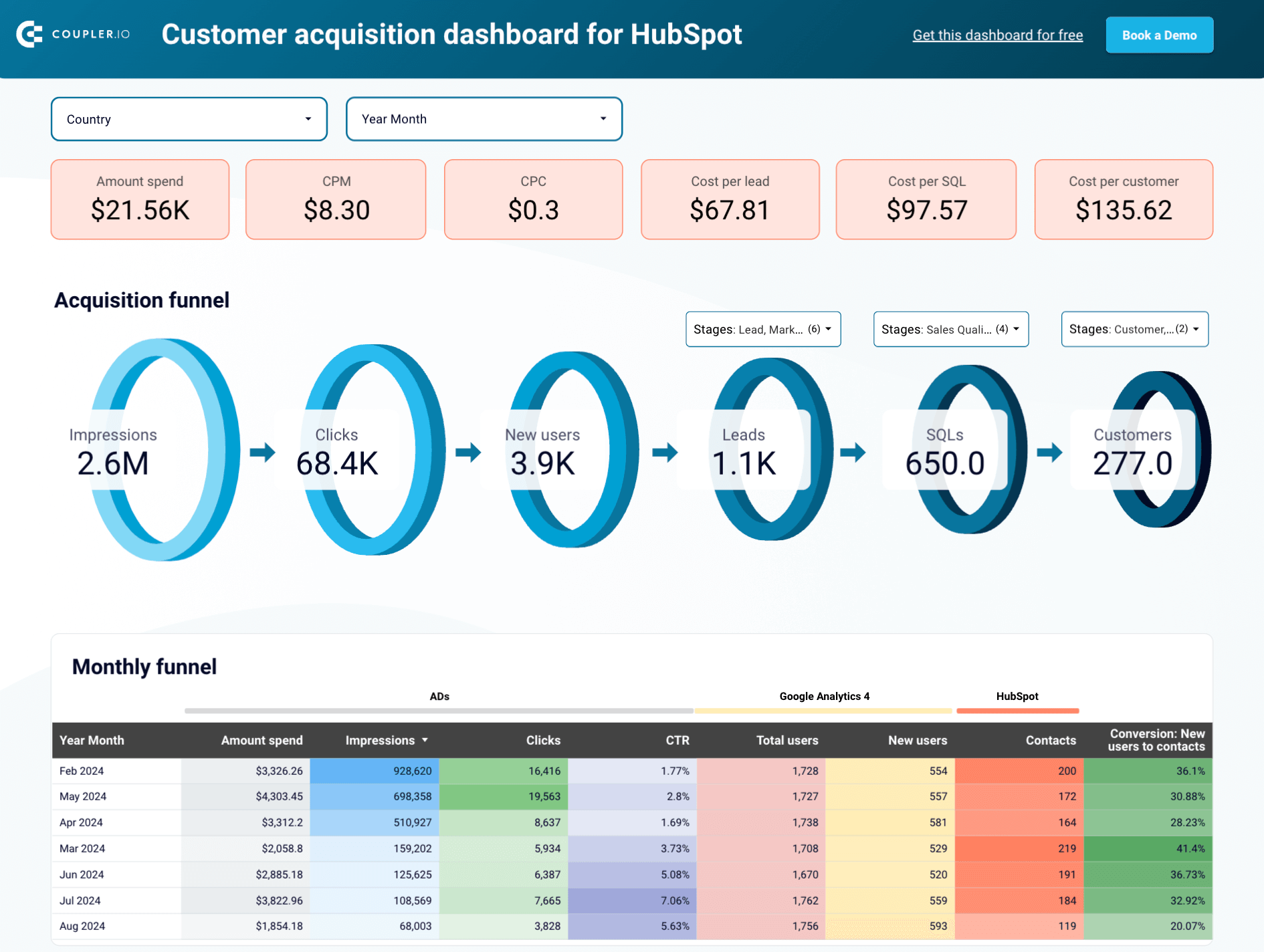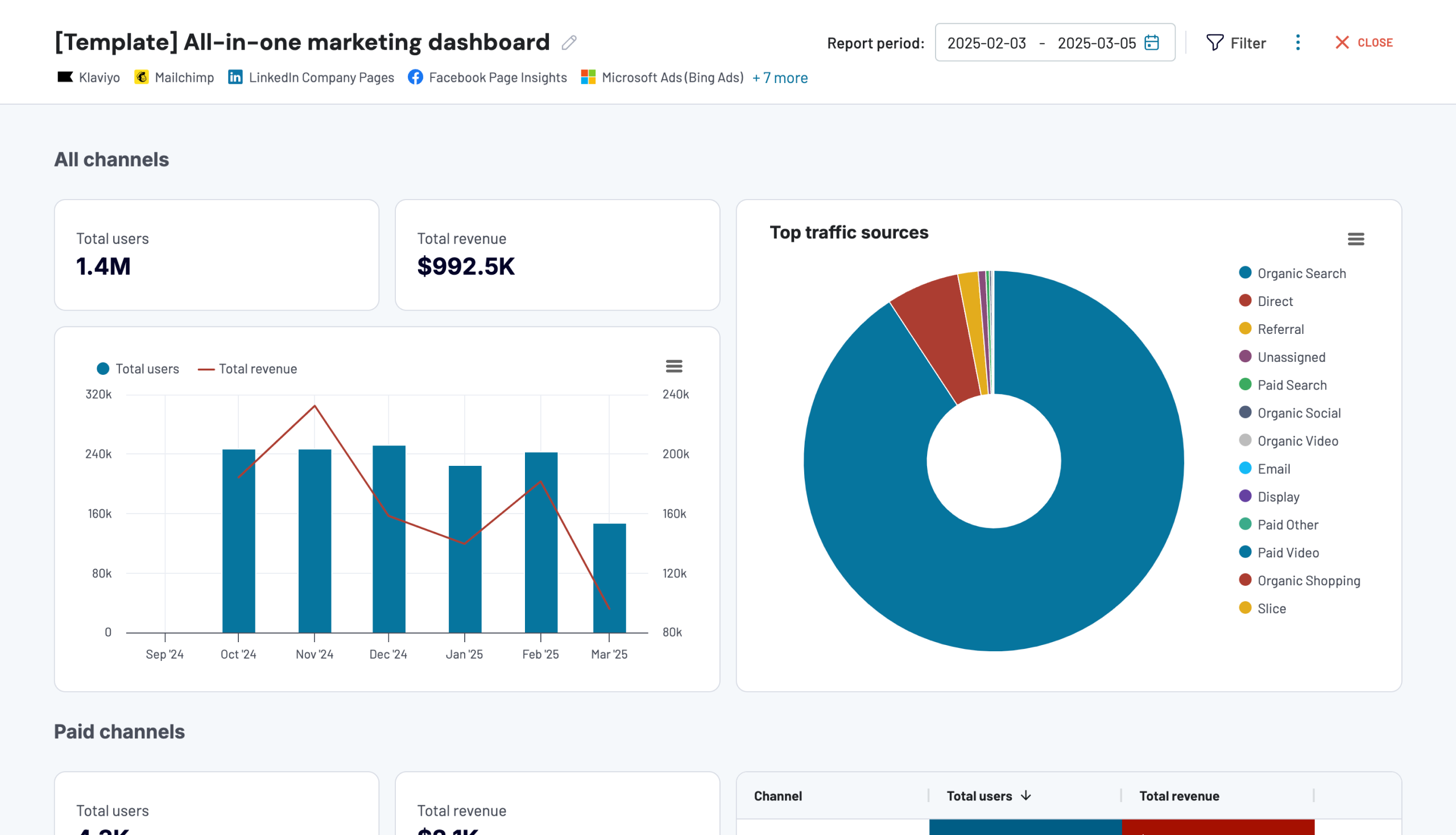What is multichannel marketing?
Multichannel marketing is the process of interacting with customers through various channels. It helps you increase engagement and drive conversions by reaching your audience where they are most active.
For example, imagine some customers discover your website through a Google search, visit it, and make a purchase. Others receive personalized offers by email and follow the link to buy. Additionally, a portion of your audience sees your Instagram ad, clicks through, and converts. All these different channels contribute to the combined success of your marketing efforts.
Difference between multichannel, cross-channel, and omnichannel marketing
To better understand multichannel marketing, let’s compare it with cross-channel and omnichannel approaches:
- Multichannel marketing allows you to engage with customers through different channels. Yet, each works separately without communicating with the others.
Imagine an ecommerce clothing brand that runs ads on Google, sends emails, and posts on Instagram. Each channel has different messages, and there’s no coordination between them.
- Contrast this with cross-channel marketing, where you integrate data across different channels for a cohesive customer experience.
For example, a customer clicks on a Google search ad for your product. Using data from this interaction, you create a personalized message offering a discount for this product and send it via email. This way, both search and email channels are integrated.
- Finally, omnichannel marketing is an advanced version of the cross-channel approach. In addition to channel integration, it enables you to interconnect the customer’s online and offline journey.
Consider a customer who visits your clothing store’s website. They choose three items and request the nearest physical store to hold them for trying on. A few days later, during an in-store visit, they try on the items and make a purchase. The sales associate sends them an email with the return policy and contact information for any further questions.
Now that you’re clear on the terms let’s explore where you can run your multichannel marketing.
Key digital marketing channels
Search engine optimization (SEO)
When potential customers need a product, service, or information, they typically input their queries into a search engine. Then, they review the results and visit the pages they find relevant. Therefore, it’s essential that you optimize your website content to achieve a higher ranking in these search results. As your rankings improve, more of your target audience will discover your business organically.
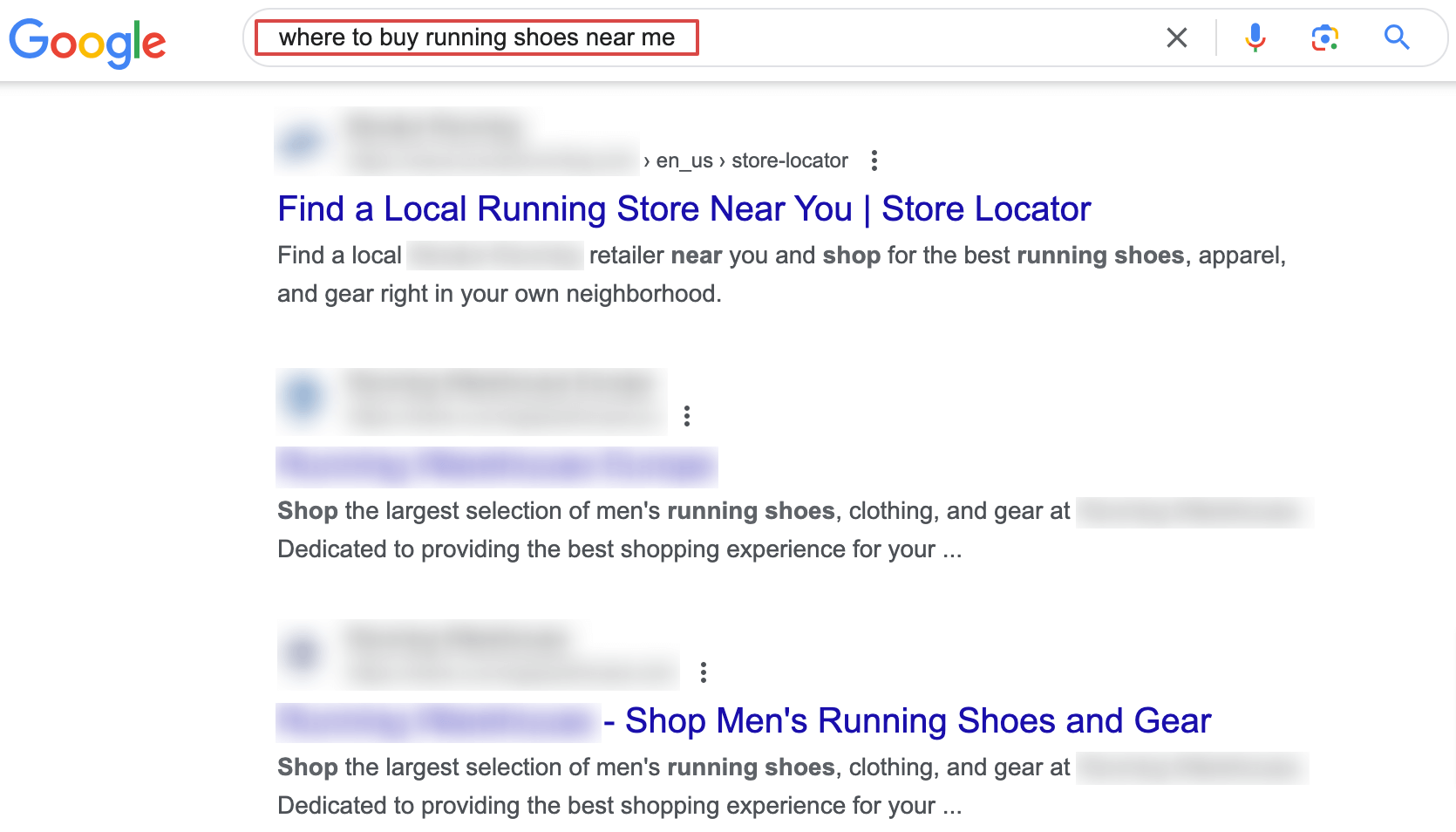
Content marketing
Content marketing involves creating useful content for your audience, such as blogs, white papers, and videos. It’s good for building trust and familiarity with your brand by making it a go-to source for information. Additionally, you can use content marketing to complement your other efforts. For example, consistently posting SEO-optimized articles can boost your organic traffic over time.
Email marketing
This channel allows you to quickly deliver personalized messages and promotions to your audience. You can use email marketing to grow your customer base and nurture leads through targeted campaigns.

Social media marketing
Using social media, you can reach a broader audience and increase customer engagement through posts, stories, and ads. Moreover, compelling content and regular updates can make your brand more relatable.
Search engine marketing (SEM)
SEM involves paid advertising on search engines. It elevates brand visibility through ads that appear at the top of search results. By targeting specific search queries, these ads lead to higher conversion rates. This way, you capture potential customers who are actively searching for related products or services.
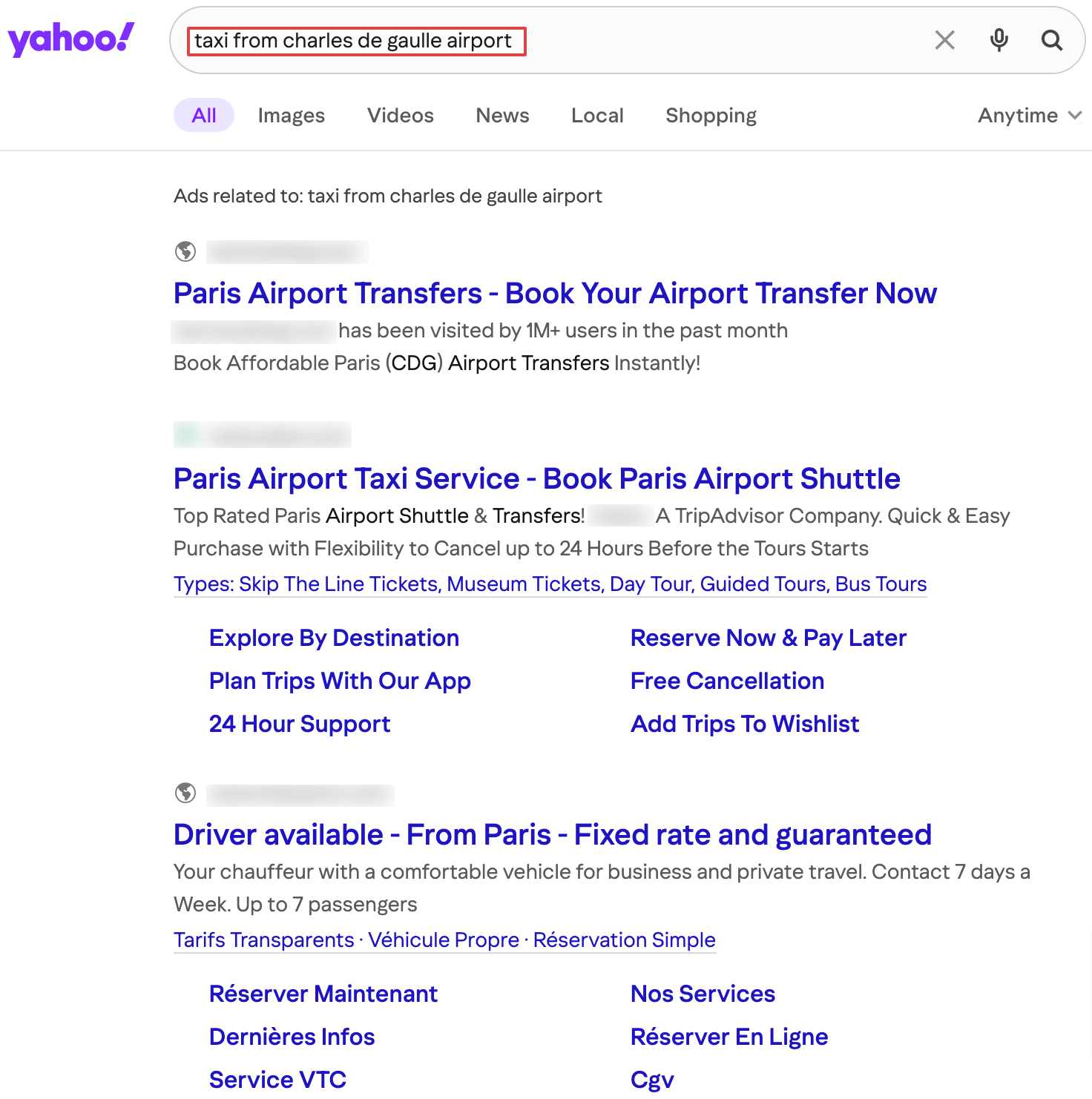
Display advertising
Here, we talk about visual ads on websites and apps. They emphasize your unique selling proposition and include a call to action tailored to the customer. By appealing directly to their interests, you encourage clicks and conversions.
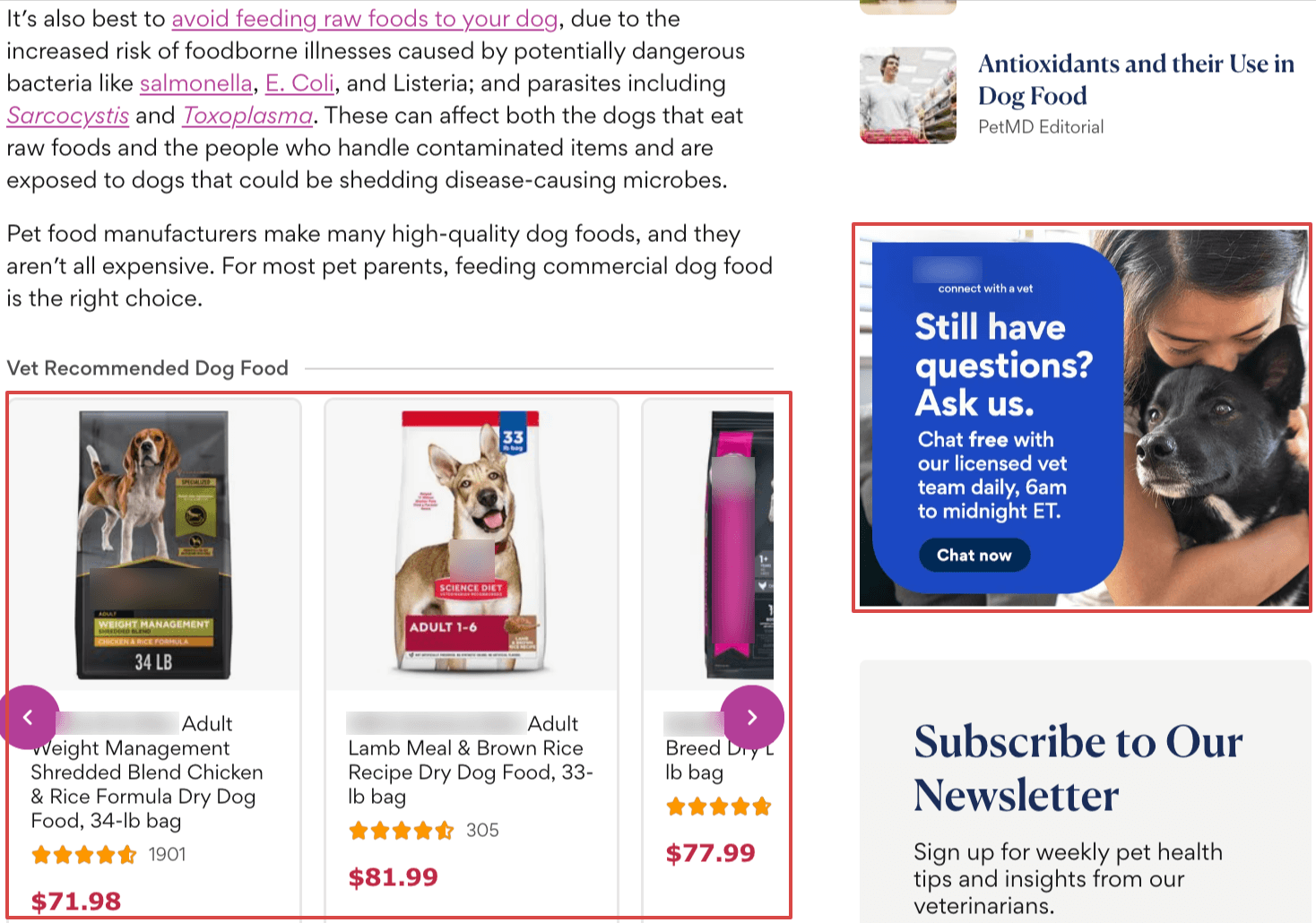
Websites and landing pages
Your website serves as your digital storefront and should include landing pages designed to convert visitors. This can be achieved by featuring product or service descriptions, forms, calls to action, and testimonials. Additionally, customers come to the website from other channels like search engines, paid ads, and email campaigns.
Channels are just the foundation of a broader multichannel marketing strategy. Let’s discover how to develop it step by step.
5 steps to develop a multi-channel marketing strategy
1. Set clear objectives
Begin by defining specific goals so you can measure your success. You can do this using SMART criteria. For example, let’s say we want to:
- increase website traffic (Specific)
- by 20% (Measurable)
- through targeted social media ads and content (Achievable)
- to boost online engagement and brand visibility (Relevant)
- within three months (Time-bound)
Make sure your goals are in line with your high-level business objectives. For example, you aim to increase traffic to your blog by 15%. This can support your broader goal of improving your online presence and building a reputation in your industry.
2. Identify ICPs and their preferred channels
Define your ICPs (ideal customer profiles) to reach the right audience through the proper channels. In simple terms, ICPs are the types of customers most likely to buy your products. By using segmentation, you can divide your market into distinct groups based on various factors.
For instance, you run a clothing brand. One ICP might be fashion-conscious professionals aged 25-35 who need work-appropriate attire.
Segmentation could be based on:
- Demographics: age, gender, income. For example, let’s take females aged 25-35 with a high income.
- Psychographics: interests, lifestyle. Imagine they are keen on modern trends and prefer Instagram for fashion inspiration.
- Behavior: shopping habits, brand loyalty. Imagine this customer segment frequently shops online and prefers new arrivals. They also respond well to email newsletters with the latest collections and special discounts.
To target these preferences, reach this audience through tailored content. First, you could share fashion tips and new arrivals on Instagram. Second, send them notifications about exclusive offers and collection updates through email. This way, you appeal to your customers through their preferred channels.
3. Create a customer journey
Map out the customer decision journey through the marketing funnel to guide prospects from awareness to purchase and beyond. At a high level, this funnel includes the top, middle, and bottom stages. You can also use models like AIDA (attention, interest, desire, action) or STDC (see, think, do, care).
Top of the funnel (ToFu)
In the initial stage, your audience becomes aware of your brand. This aligns with “attention” in AIDA or the “see” stage in STDC. For example, if we take a clothing brand, this is when someone first discovers your styles and collections. You can use social media ads and your fashion blog to engage the audience. These channels capture attention and introduce your brand to those looking for fresh options.
Middle of the funnel (MoFu)
Now, your audience starts considering your products. This stage corresponds to “think” in STDC. Using the AIDA model, we can further split it into “interest” and “desire.” After engaging with your ads and blog, leads might visit the landing page and sign up for the newsletter – the “interest” stage. They browse through product descriptions, guides, and customer reviews, including Google reviews on your website.
Email marketing and retargeting ads can move your leads to the “desire” stage. Use these channels to highlight your products’ benefits, address questions, and show how you stand out.
Bottom of the funnel (BoFu)
Finally, your prospects are ready to buy. This is where AIDA’s “action” or STDC’s “do” stage comes into play. Picture potential customers adding items to their carts. You can encourage them through personalized email offers, limited-time discounts, and retargeting ads.
After the sale, continue to engage these customers over STDC’s “care” stage. Implement loyalty programs, post-purchase surveys, and personalized recommendations to foster long-term relationships.
4. Select and prioritize your digital channels
To choose the proper marketing channels, start by evaluating audience reach. The goal is to select channels that connect with a large segment of your target market. Let’s go back to our earlier example: Your brand targets young, fashion-forward individuals, and Instagram is a suitable channel.
Next, consider audience engagement. The channel should enable meaningful interactions. For example, Instagram Stories engages users with polls, comments, and direct messages.
Cost is another critical factor. It’s important to weigh the spending of each channel against the returns it generates. While Instagram Ads may be expensive, they offer high ROI if they drive significant sales. In comparison, email marketing will be more cost-efficient, but only if it converts the audience successfully.
Make sure the channel you choose aligns with your brand’s identity. Let’s say your brand emphasizes sustainability. In that case, a green fashion blog that supports eco-friendly messaging will reinforce your values. Finally, check if you can track and measure each channel’s performance for hands-on marketing analytics.
5. Allocate your budget and resources
To finally launch your marketing efforts, you must allocate your budget thoughtfully. Consider a balanced approach for this purpose, such as the 70/20/10 rule:
- 70% for proven tactics: This portion of your budget should go to strategies that have demonstrated success. For example, if your clothing brand has seen strong returns from social media ads, continue investing in these platforms.
- 20% for innovative strategies: Allocate this share to new and creative approaches. Suppose you want to test a partnership with fashion influencers on social media platforms. This percentage allows you to explore fresh ideas without disrupting your core activities.
- 10% for experimental initiatives: Reserve this small portion for experimental tactics. For example, you could invest in a limited-time pop-up store in a new city. This helps you try out new concepts with minimal risk.
You can also use various strategies for budget allocation based on different factors and objectives.
| Budget allocation strategy | Description |
|---|---|
| Percentage of revenue | A common approach is to set aside a set rate of your revenue for marketing. Let me show you: if your clothing brand earns $1 million annually and you decide on 5%, that means a $50,000 marketing budget. This ensures you don’t overlook your business’s overall financial performance. |
| Competitive parity | Another strategy is matching your marketing budget with that of your key competitors. For instance, they are spending heavily on Google search ads. So, you should increase your expenses accordingly to remain competitive and keep pace with industry trends. |
| Objective-based budgeting | This involves setting your budget based on specific business goals. Imagine your objective is to increase online sales by 30% this year. In this case, you should allocate funds for strategies to achieve this goal, such as targeted ad campaigns. |
| ROI-based budgeting | Here, you allocate your budget based on the expected return on investment. For instance, if past Instagram campaigns have yielded high ROI, you’ll spend more on this channel. |
| Zero-based budgeting | In this approach, you start from zero and justify every expense. Case in point: If you’re launching a new clothing line, assess the cost of every marketing activity from scratch. Then, resources will be allocated based on necessity and expected impact. |
| Seasonal budgeting | Adjust your budget according to seasonal trends. To give you an idea, you can increase your budget during the holiday season when consumers are more likely to shop for gifts. This way, you capture peak sales opportunities. |
| Long-term budgeting | This strategy involves budget allocation not only for immediate marketing campaigns but also for future growth. For example, invest in customer loyalty programs that will pay off over time. |
Congratulations! Now, you’re ready to create your own strategy for multichannel marketing. If you want to make it more integrated, consider moving forward to a cross-channel marketing approach. Below, you can learn how to make this shift.
Cross-channel marketing integration
Importance of smooth transitions between channels
Transitions between channels help you create a seamless experience for your audience, regardless of where they engage with you. When each touchpoint is connected, customers can easily explore your products across platforms.
For example, a customer adds a jacket to their cart on your website and later opens your app. The item remains in the cart, allowing them to continue shopping without disruption.
Cross-channel data integration allows you to target and personalize with greater precision. You can deliver more relevant offers by understanding customers’ preferences and purchase history.
Suppose a customer frequently interacts with your brand on Facebook but has yet to make a purchase. In that case, a personalized offer sent through email could push them forward. This approach could lead to improved conversion rates and higher ROI.
Techniques for connecting various online experiences
Consistent branding and messaging
Consistent branding ensures a unified look and feel across all online platforms. This means using the same colors, fonts, and logos. Your messaging should align with the brand’s voice and values. For example, remember your clothing brand promotes eco-friendly fashion. So, every touchpoint, from social media to your website, should highlight this commitment.
Integrated multichannel marketing campaigns
Integrated campaigns bring together all your marketing channels. Let’s say you want to align your efforts across email, social media, and your website. When your clothing brand introduces a new line of activewear, you can:
- run ads on Instagram
- send promotional emails to your subscribers
- feature the collection on your homepage
This helps you maintain consistent messaging, making it more effective in converting viewers into customers.
Analyzing blended data
Here, we talk about cross-channel marketing analytics based on combined records from various sources. For example, you can merge your Shopify online store’s sales reports with Instagram Ads metrics. This allows you to understand how social media advertising impacts sales.
Marketing automation
Marketing automation involves specialized software to optimize your processes based on user behavior. Consider a customer who views your clothing collection but doesn’t purchase. At this point, an automated email can follow up with a discount offer. This saves time and ensures immediate, relevant communication with your audience.
Marketing mix modeling (MMM)
Marketing mix modeling is a statistical technique that analyzes the input of various channels into sales. Let’s say your brand spends $30,000 on Google Ads and $20,000 on Facebook Ads. After running MMM, you discover that the first generated $100,000 in sales, while the second contributed $60,000. This means Google Ads provided a 3.3x return on investment, whereas Facebook Ads delivered 3x. With this data, you can adjust future budgets, focusing more on a better-performing channel.
Attribution modeling
Attribution assigns value to different marketing touchpoints in the customer journey. This lets you understand which interactions led to conversions. Let’s say a customer saw your $50 Facebook ad and clicked through to your website but didn’t take further action. They also engaged with your $30 Instagram ad a week later but didn’t convert. Finally, after receiving a $10 email offer, they made a $200 purchase.
We can see that the email offer delivered the best result, so it makes sense to scale it by increasing the budget. In contrast, the other efforts were less effective, so their budgets could be reduced.
Tools and technologies for digital channel integration
Marketing automation platforms
These platforms provide the tools to manage, track, and scale your automated workflows across channels. Beyond just follow-ups, they can segment your audience, automate lead scoring, or sync data between your CRM and email campaigns. Examples include Mailchimp, HubSpot, Marketo, and ActiveCampaign.
Marketing attribution tools
Three essential tools for attribution are Google Analytics 4 (GA4), Amplitude, and Twilio Segment. GA4 is used by 80% of websites and offers event-based tracking. It logs actions like clicks, scrolls, and page views, helping attribute revenue to specific touchpoints.
In comparison, Amplitude focuses on user behavior in real time, showing how they interact with your site or app. It’s well-suited for detailed product analytics. Lastly, the Twilio Segment integrates data from GA4, Amplitude, etc., to deliver unified customer insights.
Dedicated marketing attribution software, such as HockeyStack and Dreamdata, is also available. These are more appropriate for B2B environments with complex sales cycles.
Data blending technologies for subsequent analytics
Consider two marketing data sources: Instagram Ads and Shopify. You transfer this data into an analytics app, such as BigQuery, and blend them. Now, you can see the direct impact of ads on your customers: who converted and how much they paid.
To connect the data source and destination, you can use API integration. This option, however, requires coding skills. It’s only suitable if you’re a developer or have one to help you. For a more straightforward solution, no-code connectors are available. Coupler.io, a report automation platform, extracts records from over 60 business applications.
Let’s delve deeper into data collection, marketing reporting, and subsequent analytics.
Tools to collect and analyze data for multichannel marketing
Data sources
First, access GA4 to gather data on traffic from multiple channels. To analyze ad campaign effectiveness, you need to export data from your advertising platforms. These could be Microsoft (Bing) Ads, Meta Ads (Facebook and Instagram), Google Ads, TikTok Ads, Amazon Ads, or others. For customer data and sales activity records, use CRMs such as Salesforce, Pipedrive, or HubSpot.
These data sources are the most common for analyzing acquisition in multichannel marketing. At the same time, the list can be expanded by email tools like Klaviyo or Mailchimp, social media platforms, and more.
Data platforms
Platforms like Twilio Segment and Coupler.io transfer data from sources to analytics applications, such as BI tools. For instance, Coupler.io allows you to pull records from multiple sources automatically and merge them into a single dataset. You can then prepare a report by filtering, sorting, and editing or rearranging columns. Finally, send this report to your preferred tool. Additionally, Coupler.io refreshes data in the destination, keeping it in sync with any changes in the source.
Business intelligence (BI) tools
BI tools help transform your data into actionable insights regarding metrics and trends. Here, you can build dynamic interactive dashboards to present complex information understandably. Options vary from Google Sheets to more advanced options like Looker Studio, Tableau, or Power BI.
Use digital insights to optimize channel performance
A quicker approach to analytics is using dashboard templates. They let you skip the lengthy report creation process and go straight to insights. For instance, Coupler.io offers marketing reporting templates with built-in connectors to various channels. Let’s review some of them below.
Multi-channel PPC dashboard
The PPC multi-channel dashboard template helps compare your campaign performance across advertising platforms. You can connect your ad accounts to the dashboard without switching between interfaces.
The template supports the following data sources:
- Google Ads
- X (Twitter) Ads
- LinkedIn Ads
- Facebook Ads
- Quora Ads
- Instagram Ads
- Microsoft (Bing) Ads
- TikTok Ads
Here’s what you can do with this dashboard:
- Filter data by date: Track variations in performance over time. This helps you understand the impact of seasonal trends or changes on your campaigns.
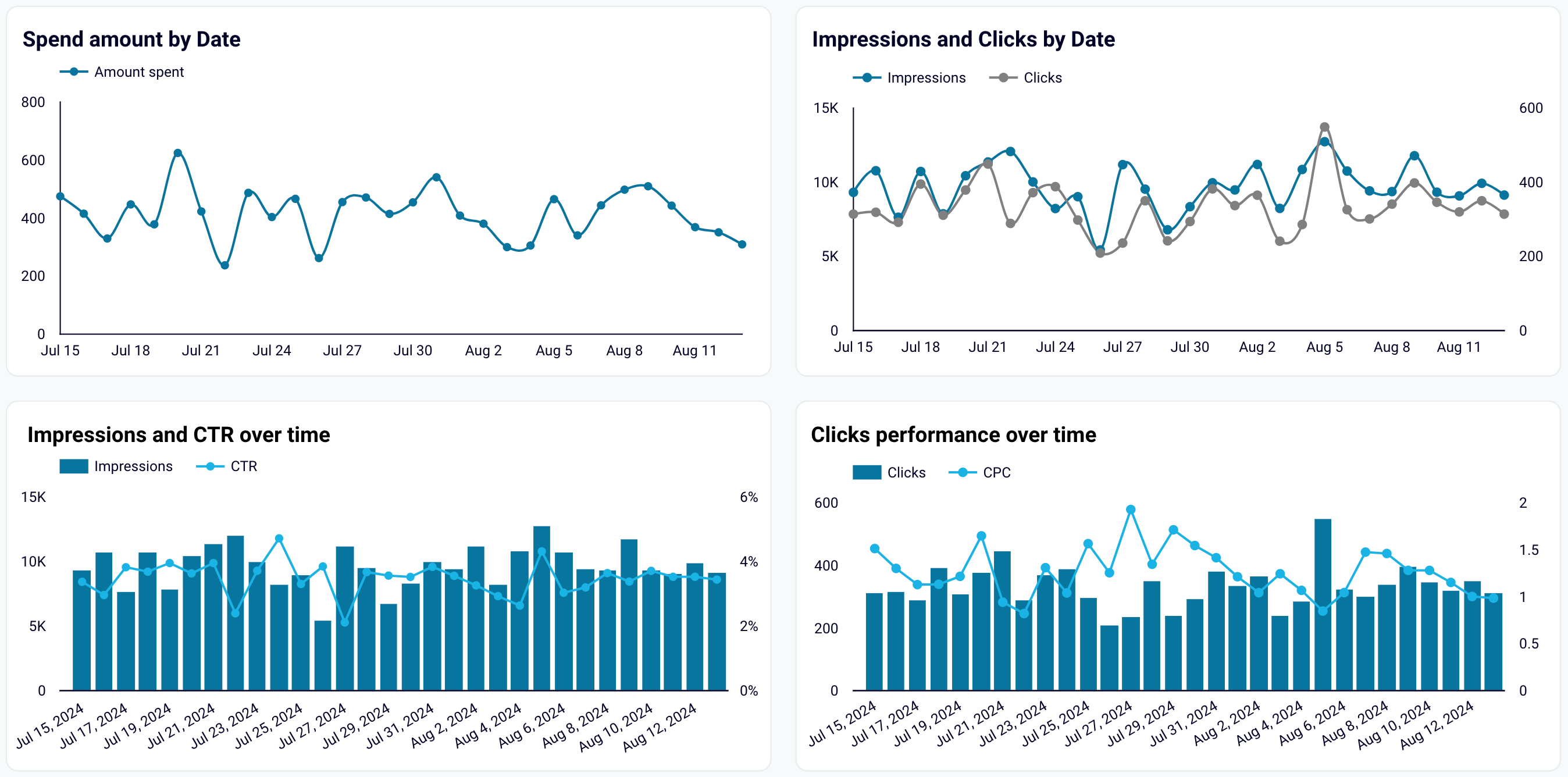
- Control key spending metrics: Monitor your spending, including cost per click and cost per mille. This helps you stay informed about your advertising budget and evaluate the cost efficiency of each campaign.

- Analyze channel performance: Determine how well each advertising platform performs. Compare critical metrics like click-through rates and impressions to evaluate each channel’s effectiveness.

- Compare campaigns: Assess which campaigns provide the best ROI. Analyze performance side-by-side to identify opportunities for optimization.
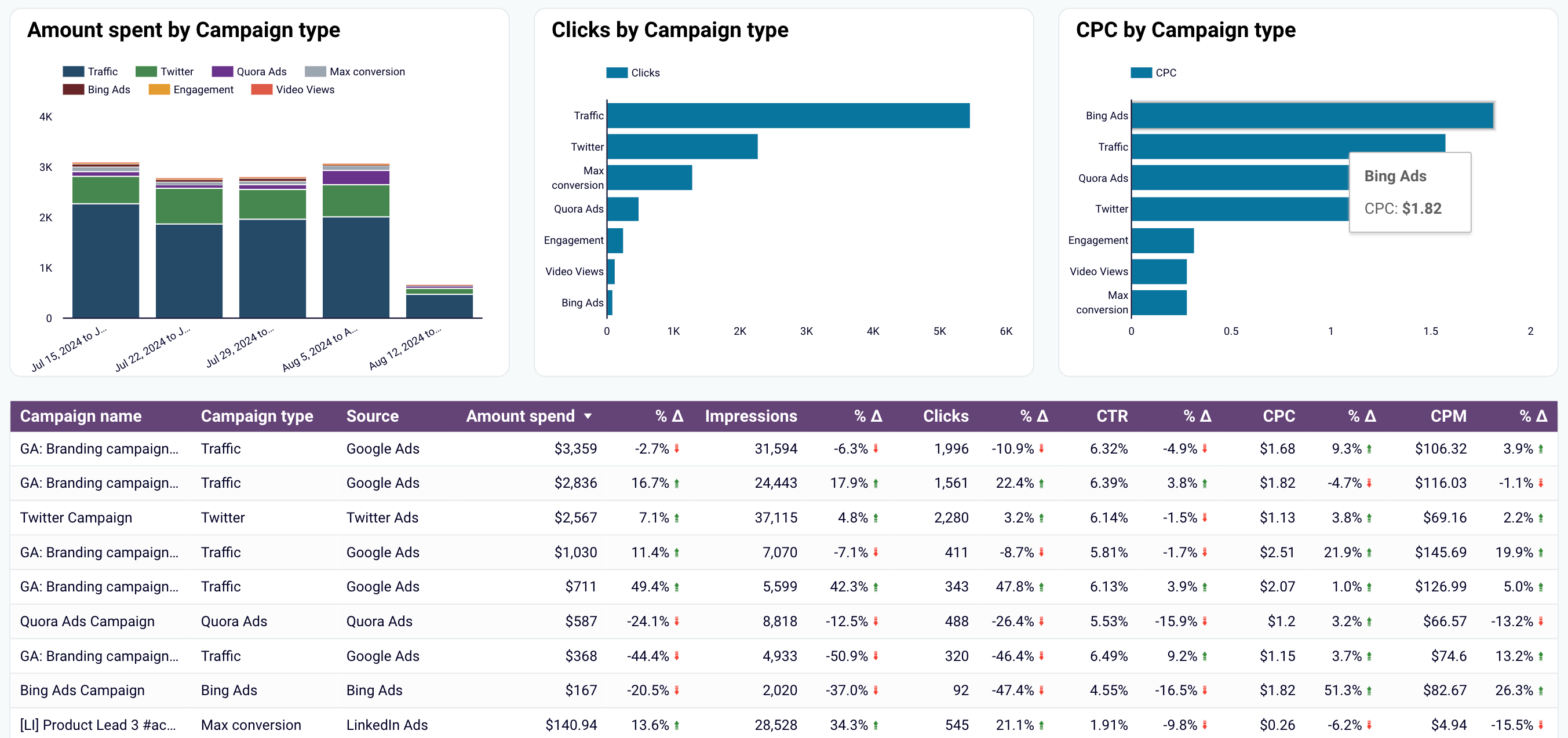
This dashboard is available in the Coupler.io UI and as a template in Google Sheets, Looker Studio, Power BI, and Tableau.
Customer acquisition dashboards for Pipedrive and HubSpot
Customer acquisition Looker Studio dashboard templates let you analyze your lead generation funnel. You can use them to track trends over time and compare the performance of different channels. These templates integrate data from the CRM with metrics from GA4 and various ad platforms.
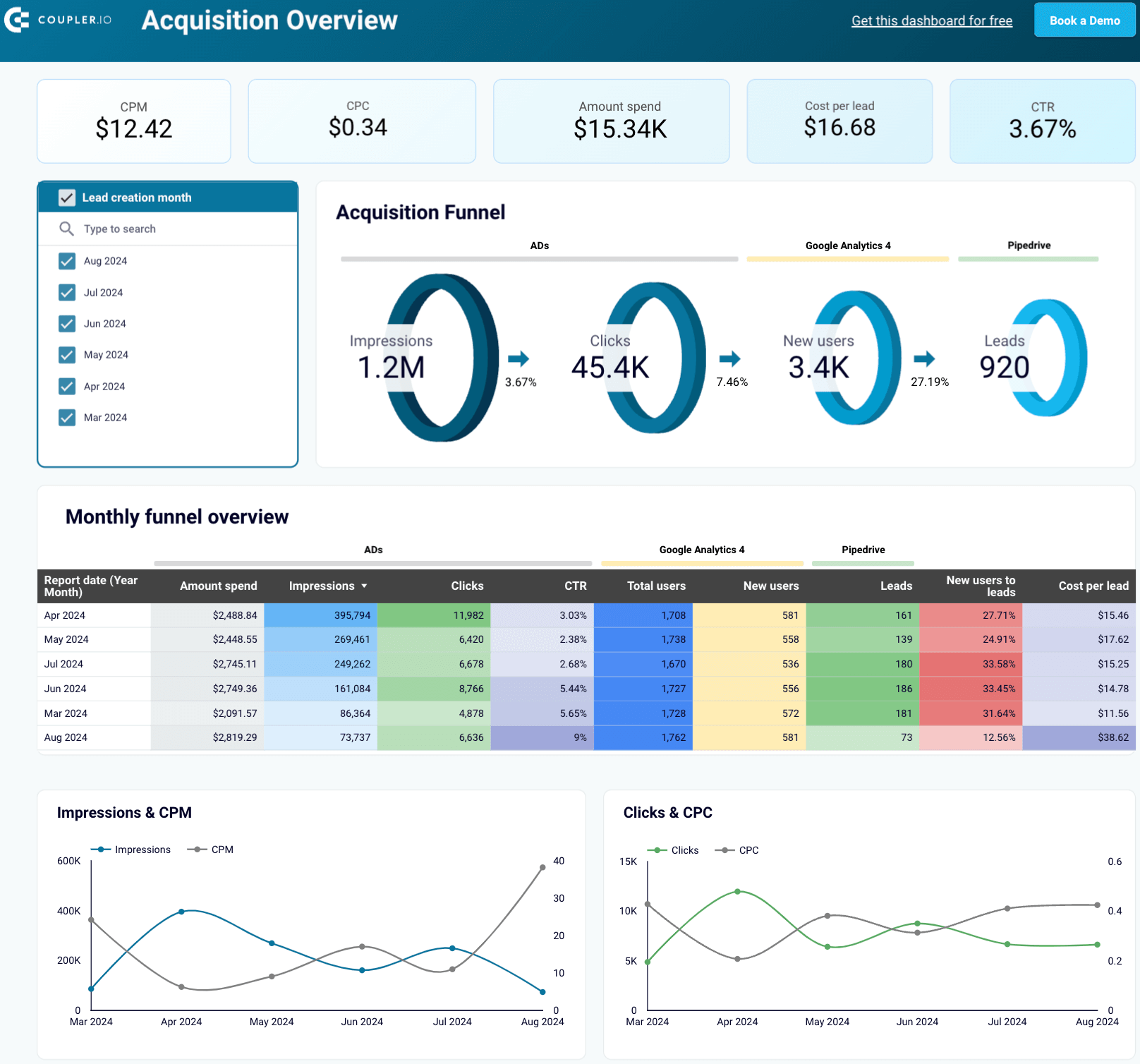
Consider several ways this template can be helpful:
- Perform multi-source marketing funnel analytics: Check the impressions and clicks generated by your ads. Look at the number of users visiting your site and the leads entering your Pipedrive or HubSpot. By comparing conversion rates at each stage with industry benchmarks, you can identify and address any leaks in the funnel.
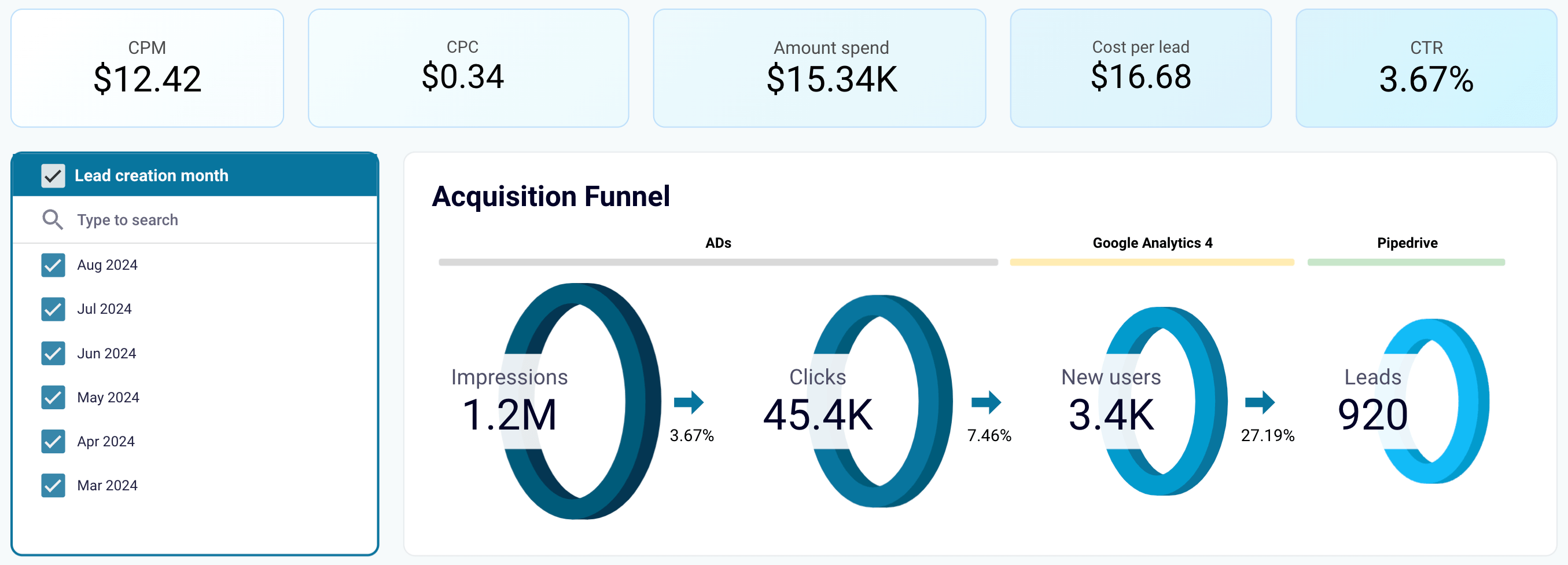
- Track the funnel month-by-month: Monitor changes in your funnel monthly. Look for correlations with your marketing and lead generation activities. Identify which months performed best and analyze campaigns that contributed to those results.

Learn more about marketing funnel reporting.
- Compare spending and conversion: Evaluate your expenses on different platforms alongside conversion rates. For instance, you may find that one month, most of your budget was spent on Facebook Ads, but conversions to leads decreased. This helps you adjust your marketing strategy and allocate your resources better.

Each of the templates is compatible with a single CRM – either Pipedrive or HubSpot.
Google Ads vs. Meta Ads dashboard
The Google Ads vs. Meta Ads dashboard template in Looker Studio lets you compare your ad performance across these two platforms.
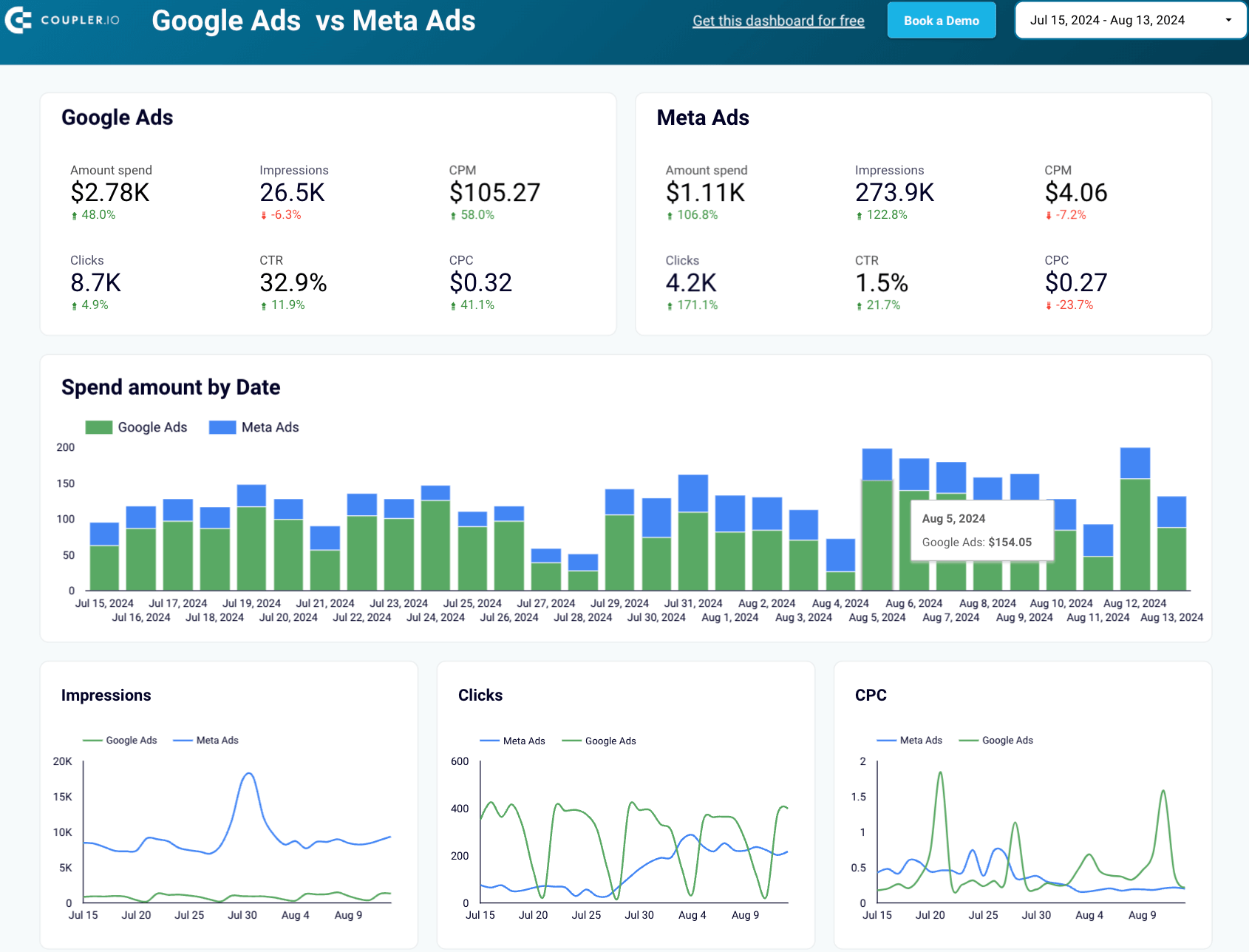
See how to make the most of this template:
- Compare metrics across platforms: Track key metrics to determine which platform offers the best ROI. This insight allows you to prioritize your advertising efforts.

- Track spending over time: Monitor your spending trends to understand how much you invest in each platform over a set period. This helps you manage your marketing budget and ensures your spending aligns with your campaign goals.

- Discover your monthly dynamics: Overview your month-to-month performance to observe trends. Identify patterns, expect performance changes, and adjust your strategies accordingly.
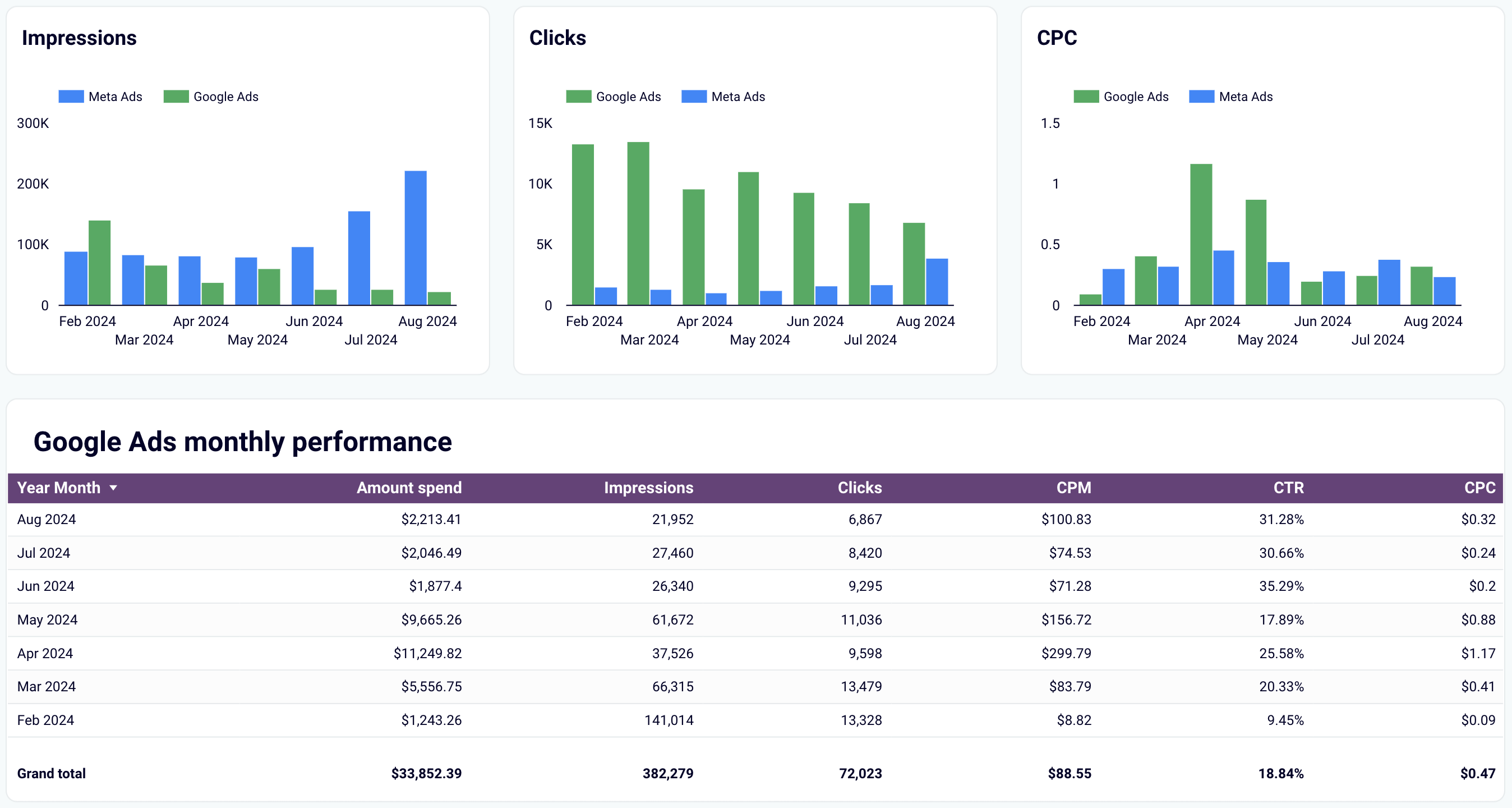
By comparing data from these platforms, you can optimize your budget allocation and improve your campaign outcomes.
All-in-one marketing overview
The all-in-one marketing overview template allows you to track performance across various channels. It aggregates data from GA4, Google Search Console (GSC), ad platforms, social media, email tools, and YouTube.
Key takeaways from this dashboard include:
- All channels’ overview: Get a high-level summary of how all your marketing channels perform. See each one’s contribution to the overall traffic.
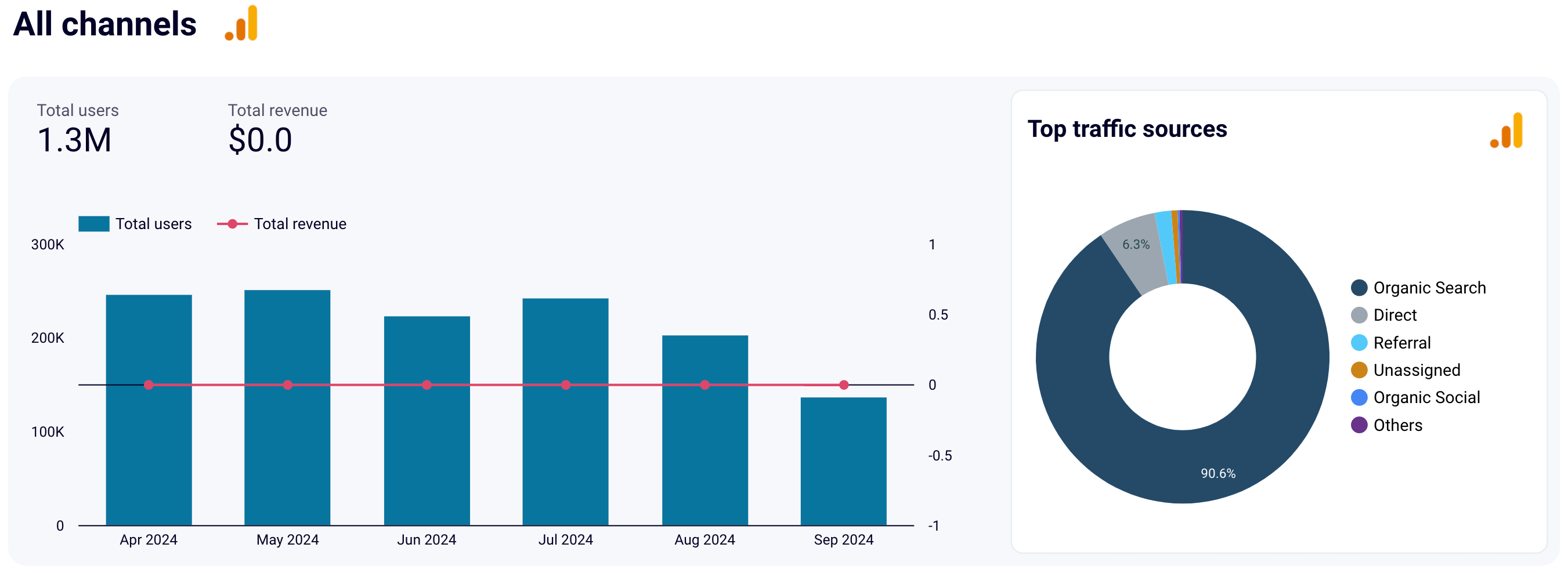
- PPC analysis: Track the month-to-month performance of your paid channels. Explore results across all the platforms or use filters to analyze them separately.
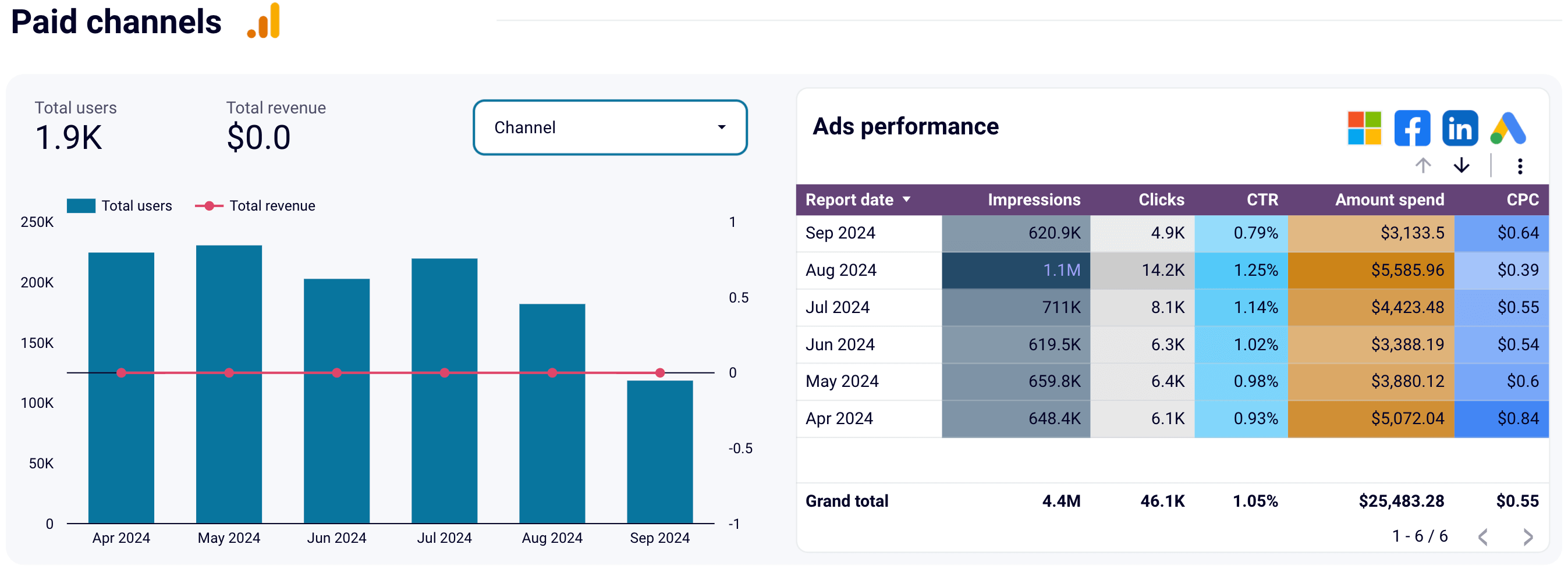
- Insights into organic traffic: Check impressions, clicks, CTR, and average position using data from GSC. You can also discover total users and revenue specific to Google or other search engines, such as Bing, Yahoo, DuckDuckGo, etc.
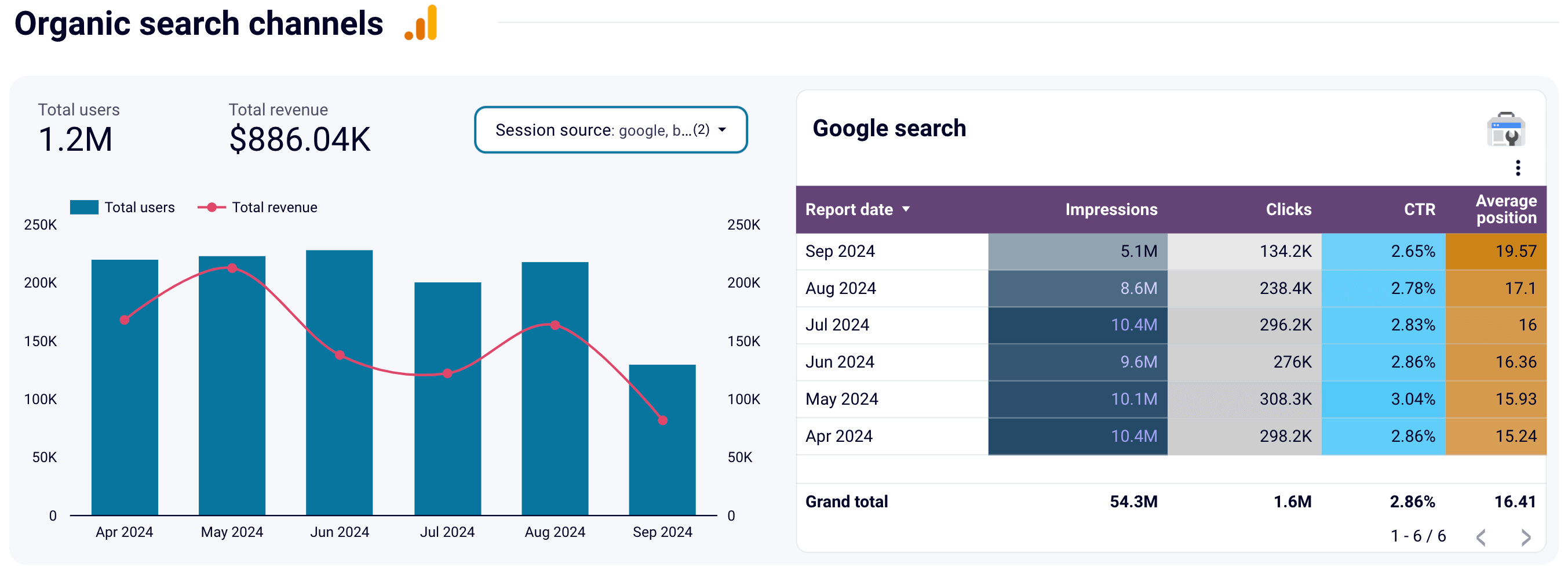
- Social media performance: Review a detailed breakdown of your social media channels. Track impressions and page views across all of them or focus on specific platforms.
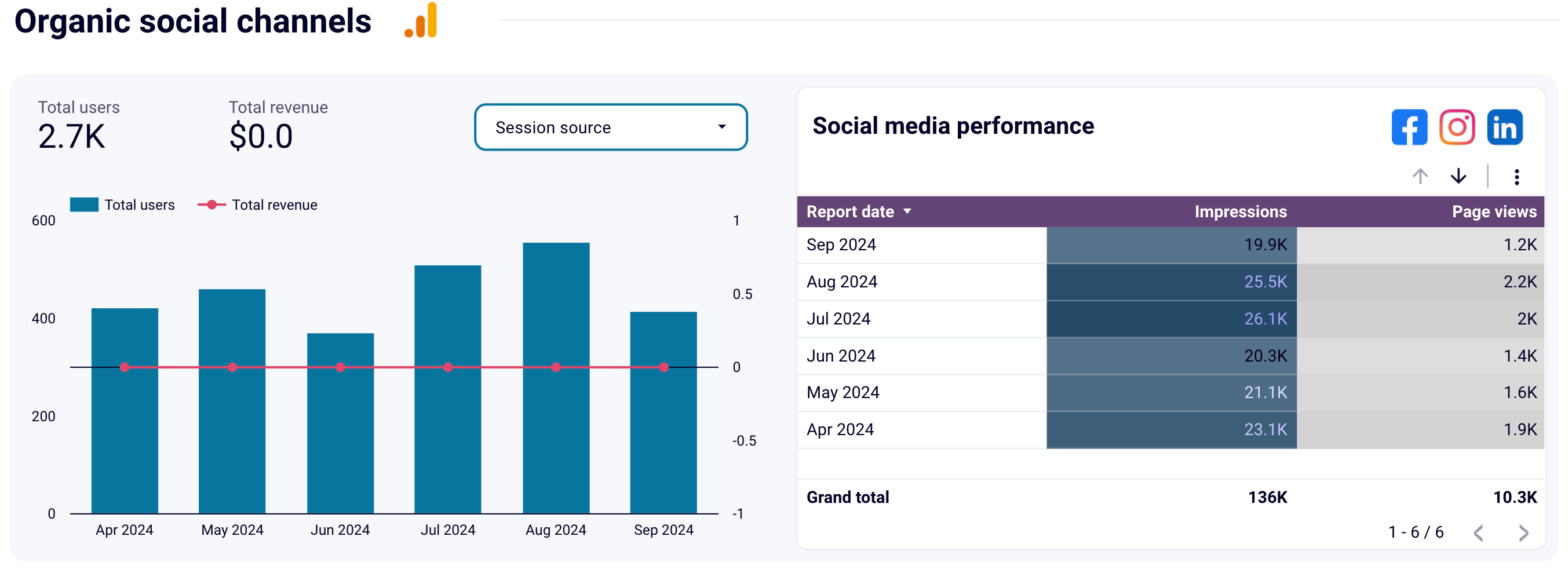
- Email marketing metrics: Assess your email marketing efforts based on Klaviyo and Mailchimp data. Examine metrics like emails delivered, open rates, bounces, unsubscribes, and clicks.
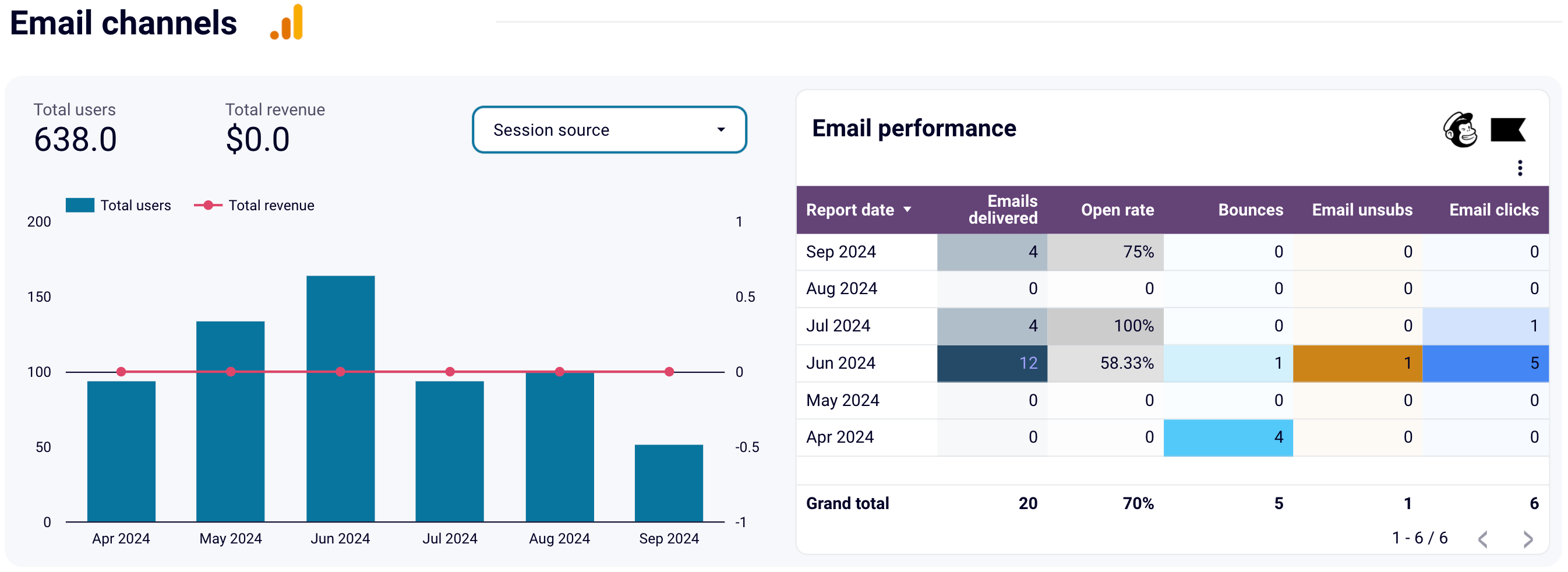
This way, the dashboard provides a complete view of your multichannel marketing performance. It is available in Coupler.io and as a template in Looker Studio. Try it right away for free!
Learn how to conduct marketing forecasting to improve campaign outcomes and overall team performance.
Tips on multi-channel marketing personalization
To effectively engage your target audience, it’s essential to personalize your marketing efforts. Discover why this matters and how to implement it.
Benefits of marketing personalization
More consistent and relevant customer experiences
Personalized online experiences help your brand foster a deeper connection with its customers. By understanding their preferences, your brand can offer more consistent and relevant interactions. This makes customers feel appreciated, and their journey through your online store becomes shorter and more efficient.
For example, a returning customer often buys casual wear. Showing them similar items or exclusive deals will maintain their attention and prevent distractions. This fosters loyalty, retention, and customer lifetime value.
Improved conversion rate
The more personalized your offers are, the more likely customers will act on them. For instance, sending special discounts on items that shoppers frequently browse encourages conversion.
Higher average order value (AOV)
Targeted product suggestions based on past purchases can lead to larger orders. For example, a customer who buys a jacket might be shown accessories like matching scarves or gloves. This tailored approach often leads to a higher AOV, as customers feel the offers are curated just for them.
Techniques for personalizing content across channels
Website personalization with tracking and cookies
Your website can use cookies to track visitors’ behavior and inform the content they will see. For instance, if a visitor has browsed winter jackets, your site can prioritize those products for them on future visits.
IP marketing takes things a step further. Let’s use Clearbit Reveal as an example. This tool performs a reverse IP lookup, meaning it translates IP addresses into domain names. This way, it identifies your website visitor’s company, industry, revenue size, and location. Your site can then display relevant content tailored to this information. This ensures dynamic content delivery, even for first-time visitors.
Recognizing anonymous website traffic is another powerful technique. Tools like RB2B identify visitors and deliver their LinkedIn profiles in real time via Slack. As a result, you can customize the experience based on these insights.
Personalization of online ads
Use data from your website and other sources to target customers with personalized ads. This includes past browsing behavior, location, demographics, and other details. Here’s how you can apply this information:
- Audience personalization: Target ads based on customer behavior, such as pages visited or products viewed.
- User journey targeting aligns your ads with where the user is in the buying process.
- Geo-targeting and device targeting allow ads tailored to the customer’s location and device type.
- Demographic targeting uses information like age or gender to make your ads more relevant.
- Behavioral prospecting shows ads to users similar to your best customers.
- Contextual targeting places your ads where they’re most relevant to the user’s context.
- Parameter targeting adjusts ad content based on variables like time of day or weather.
- One-to-one personalization can get even more specific:
- Product retargeting ensures visitors see ads for products they’ve shown interest in.
- Dynamic creative optimization (DCO) results in ads that adapt their messaging based on real-time data.
Email marketing personalization
Email marketing is another way to create personalized experiences for your customers. Begin by segmenting your email lists using customer preferences, purchase behavior, or demographic data. Then, personalize the email content itself. Dynamic content enables you to customize subject lines and body text based on the recipient’s interests or past purchases. For example, if a customer frequently buys summer wear, you can prioritize similar products in the email.
Data enrichment
Data enrichment tools provide a deeper understanding of your customers. For example, Clay connects to your email, calendar, and social media to gather information. Then, it enriches each contact with extra details, like work history and location. This helps you personalize communications further to build stronger customer relationships.
Balancing personalization with digital privacy concerns
Personalization is valuable for digital marketing, but it often conflicts with privacy. The need for data protection has grown, and governments worldwide have enacted data protection laws over the past years. Notable ones include the EU’s General Data Protection Regulation (GDPR) and the California Consumer Privacy Act (CCPA).
So, you have to balance personalization with privacy effectively. We suggest you consider the following techniques:
Contextual advertising
Contextual advertising focuses on alignment with a webpage’s content. Instead of targeting individual users, this method targets the content they view. This ensures the ads are relevant to users’ immediate interests without compromising privacy.
Indirect attribution
With the decline of third-party cookies, indirect attribution has become increasingly important. Brief reminder: These cookies are set by external domains, unlike first-party ones. Previously, marketers used them to track user behavior across websites. However, privacy concerns led to stricter regulations and browser updates that block these cookies.
Therefore, it is crucial to find new ways to track conversions and evaluate your marketing efforts. For instance, analyze how your advertising affects brand search activity. You can do this with Coupler.io’s brand awareness dashboard template for Power BI. It shows paid impressions over time and compares them with branded ones through Google Search Console.
Brand awareness dashboard template in Power BI
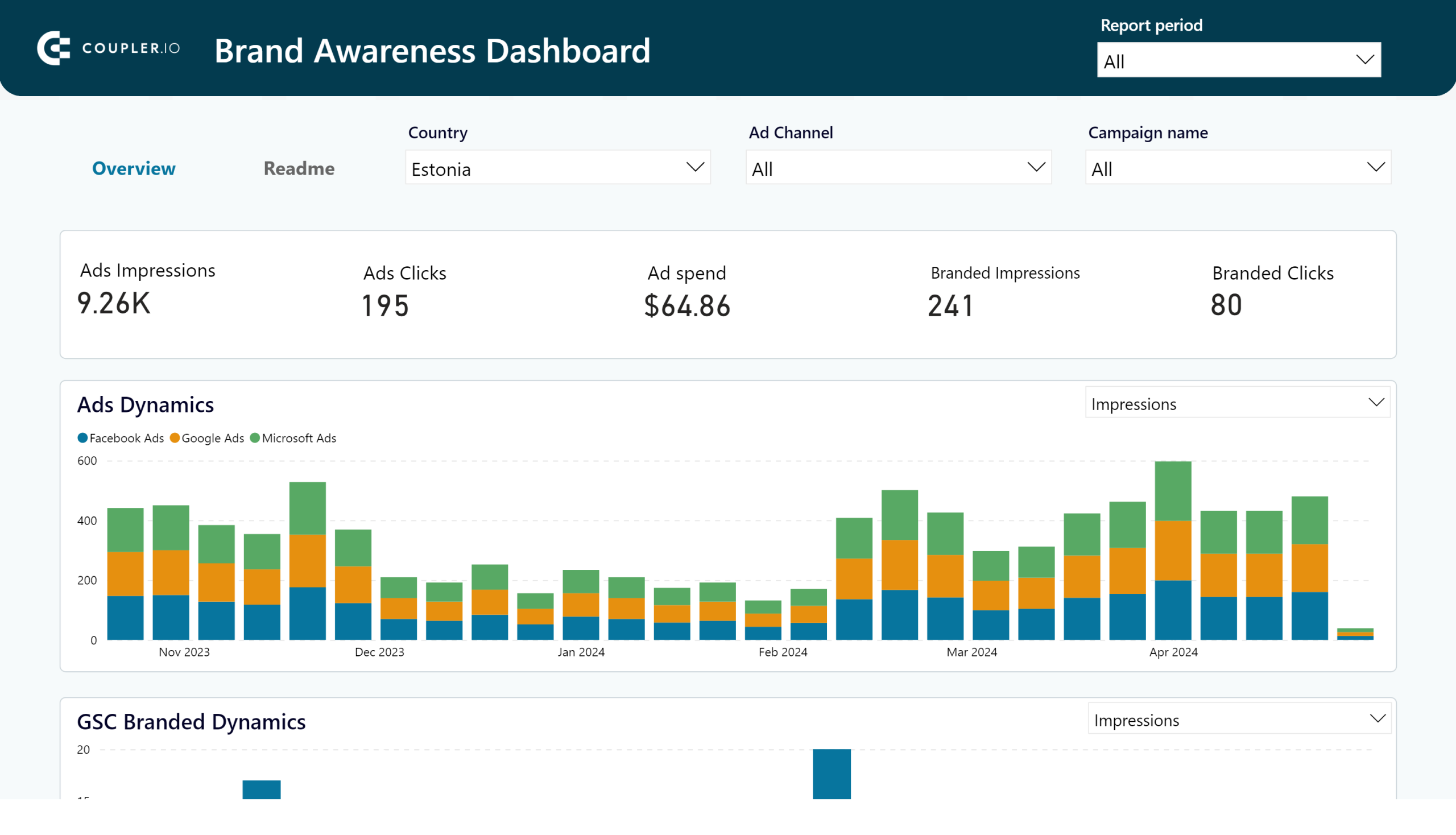 Preview dashboard
Preview dashboard
Brand awareness dashboard template in Power BI
Preview dashboardSo, you can see how often users search for your brand name or related keywords after interacting with your ads.
Learn more about brand marketing vs. performance marketing.
Encouraging customers to share data
One more practical approach is to entice customers to share their data. You can achieve this through surveys and sign-up forms. When users willingly provide information, it allows for personalized marketing while respecting privacy.
Transparency in data collection
Explain the purpose behind data collection and allow users to decide whether to share their information. Be open about what data you gather, how it will be used, and with whom it will be shared. Clearly outline your privacy policies in simple, easy-to-understand language to foster trust.
Minimizing data collection
Only gather the data necessary for personalization. Avoid collecting excessive or irrelevant personal information that may affect user privacy. Data minimization practices can reduce the amounts stored while still allowing for personalization.
Using these strategies, you can achieve a balance, creating a respectful and engaging digital experience. Now, let’s shift our focus to addressing the other challenges of the multichannel approach to marketing.
Challenges in multi-channel marketing
Maintaining consistency across online channels
Using a diversity of communication channels, you’re at risk of disrupting your brand’s unified image. It’s easy to lose track of tone, style, or marketing messages.
For instance, your Instagram ads portray your brand as friendly and informal, but your Forbes press release comes across as formal. In that case, customers may feel confused, and this feeling can impact their purchasing decisions.
To tackle this challenge, develop a unified communication strategy. This should guide all customer interactions. Define the brand’s right message and tone, as well as ensure every marketing team member aligns with this approach. This consistency is critical to building trust and recognition across all channels.
Managing digital resources and budget allocation
Allocating a fair budget for each marketing channel can be challenging. Let’s say your PR team published a press release on Forbes. After that, you notice a spike in website traffic. Some visitors came from organic search results. Others arrived through brand ads. One more bunch of visitors simply typed your domain directly into their browser. So, traffic directly from Forbes might seem insignificant, but this doesn’t mean your press release failed.
The challenge is that public relations often influences traffic types other than the referral. As a result, it’s tough to measure their exact impact. Here, you need complex analytics far beyond mere marketing attribution. This is your way to avoid underfunding PR efforts or overinvestment in other channels.
Digital marketing attribution modeling
Marketing attribution models are frameworks for assigning value to specific touchpoints. However, traditional models can yield different results.
For example, one option is the last-click model. It gives full credit to the last interaction before a conversion. For instance, if a customer visits your website after reading a newsletter, this touchpoint receives all the credit for the sale. So, this model ignores earlier interactions that may have influenced the decision.
In contrast, the first-click model allocates credit to the first point of contact. This means if a customer first finds your brand through an ad, that ad receives all the credit. Nevertheless, this one overlooks the impact of subsequent interactions.
To address this issue, consider alternative options. For example, GA4 offers a data-driven model that uses machine learning to analyze each click’s contribution. It compares actual outcomes with potential scenarios to determine which touchpoints drive conversions. By doing so, this model assigns credit to the interactions most likely to lead to sales.
Keeping up with rapidly evolving digital platforms
Digital platforms constantly change, and so do the trends in marketing. Let’s take the shift from Universal Analytics to Google Analytics 4. GA4 introduced a new reporting interface and a different data measurement model. It also removed the bounce rate and introduced new reporting metrics instead. As a result, marketers had to retrain themselves to use the new system effectively.
Another shift relates to cookie banners, which notify users about cookie use and request their consent. Previously, you only needed to inform users before tracking their behavior. However, the GDPR changed that, requiring valid consent before collecting data. If visitors decline, cookies can’t be set.
So, you should keep track of developments in the digital landscape to stay caught up.
Importance of automating multichannel marketing reporting
To track your multichannel marketing performance, ensure your reporting is well-optimized. While you can manage this manually, automating the process is much more efficient. With numerous channels and vast amounts of data, automation not only saves time but also reduces the risk of human error.
With Coupler.io, you can extract data from your platforms, prepare custom reports, and import them to the destination in minutes. Additionally, free dashboard templates are available for predefined report creation.
Try it out for free and see how it contributes to your multichannel marketing efforts!
Automate reporting with Coupler.io
Get started for free
